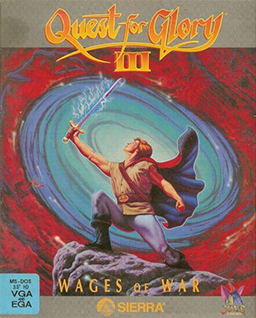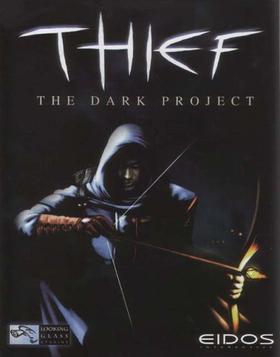
Quest for Glory is a series of hybrid adventure/role-playing video games, which were designed by Corey and Lori Ann Cole. The series was created in the Sierra Creative Interpreter, a toolset developed at Sierra specifically to assist with adventure game development. The series combines humor, puzzle elements, themes and characters borrowed from various legends, puns, and memorable characters, creating a 5-part series in the Sierra stable.
A thief is a person who takes another person's property or services without consent.

Final Fantasy III is a role-playing video game developed and published by Square for the Family Computer. The third installment in the Final Fantasy series, it is the first numbered Final Fantasy game to feature the job-change system. The story revolves around four orphaned youths drawn to a crystal of light. The crystal grants them some of its power, and instructs them to go forth and restore balance to the world. Not knowing what to make of the crystal's pronouncements, but nonetheless recognizing the importance of its words, the four inform their adoptive families of their mission and set out to explore and bring back balance to the world.

Baldur's Gate is a series of role-playing video games set in the Forgotten Realms Dungeons & Dragons campaign setting. The series has been divided into two sub-series, known as the Bhaalspawn Saga and the Dark Alliance, both taking place mostly within the Western Heartlands, but the Bhaalspawn Saga extends to Amn and Tethyr. The Dark Alliance series was released for consoles and was critically and commercially successful. The Bhaalspawn Saga was critically acclaimed for using pausable realtime gameplay, which is credited with revitalizing the computer role-playing game (CRPG) genre.

Quest for Glory III: Wages of War is a hybrid adventure/role-playing video game released in 1992 for MS-DOS. It is the third entry in the Quest for Glory video game series and the sequel to Quest for Glory II: Trial by Fire.
A stealth game is a type of video game in which the player primarily uses stealth to avoid or overcome opponents. Games in the genre typically allow the player to remain undetected by hiding, sneaking, or using disguises. Some games allow the player to choose between a stealthy approach or directly attacking antagonists, but rewarding the player for greater use of stealth. The genre has employed espionage, counter-terrorism, and rogue themes, with protagonists that are special forces operatives, special agents, secret agents, thieves, ninjas, or assassins. Some games have also combined stealth elements with other genres, such as first-person shooters and also platformers.

Warren Evan Spector is an American role-playing and video game designer, director, writer, producer and production designer. He is known for creating immersive sim games, which give players a wide variety of choices in how to progress. Consequences of those choices are then shown in the simulated game world in subsequent levels or missions. He is best known for the critically acclaimed video game Deus Ex that embodies the choice and consequence philosophy while combining elements of the first-person shooter, role-playing, and adventure game genres. In addition to Deus Ex, Spector is known for his work while employed by Looking Glass Studios, where he was involved in the creation of several acclaimed titles including Ultima Underworld, Ultima Underworld II, System Shock, and Thief: The Dark Project. He is employed by OtherSide Entertainment, where he was part of the development team for now-cancelled System Shock 3. He is currently working on a new immersive sim based on an original intellectual property.
Hitman is a stealth video game franchise created by IO Interactive. Each installment of the series has players assume the role of a cloned contract killer named Agent 47, who travels around the world to assassinate various targets that are assigned to him by the fictional International Contract Agency (ICA). Gameplay focuses on freedom of approach, with most levels placing the player in a large sandbox location where they have free rein to explore and find different ways to reach and eliminate their targets. Stealth is a major component of the gameplay and players are given various tools to accomplish their objectives, such as suppressed weaponry, items which can be used as improvised weapons, and the ability to take disguises which allow 47 to blend in with non-player characters (NPCs) and bypass most restricted areas without rousing suspicion.

Flight Unlimited II is a 1997 flight simulator video game developed by Looking Glass Studios and published by Eidos Interactive. The player controls one of five planes in the airspace of the San Francisco Bay Area, which is shared with up to 600 artificially intelligent aircraft directed by real-time air traffic control. The game eschews the aerobatics focus of its predecessor, Flight Unlimited, in favor of general civilian aviation. As such, new physics code and an engine were developed, the former because the programmer of Flight Unlimited's computational fluid dynamics system, Seamus Blackley, had left the company.

Thief: The Dark Project is a 1998 first-person stealth video game developed by Looking Glass Studios and published by Eidos Interactive. Set in a fantasy metropolis called the City, players take on the role of Garrett, a master thief trained by a secret society who, while carrying out a series of robberies, becomes embroiled in a complex plot that ultimately sees him attempting to prevent a great power from unleashing chaos on the world.
Terri Brosius is an American musician, voice actress, and game designer, best known in gaming circles as the voice of SHODAN in the System Shock series.

Thief: Deadly Shadows is a stealth video game developed by Ion Storm for Microsoft Windows and Xbox that was released in 2004, on May 25 in North America and on June 11 in Europe. It is the third video game in the Thief series.

Thief II: The Metal Age is a 2000 stealth video game developed by Looking Glass Studios and published by Eidos Interactive. Like its predecessor Thief: The Dark Project, the game follows Garrett, a master thief who works in and around a steampunk metropolis called the City. The player assumes the role of Garrett as he unravels a conspiracy related to a new religious sect. Garrett takes on missions such as burglaries and frameups, while trying to avoid detection by guards and automated security.
The Dark Engine was a game engine developed by Looking Glass Studios and was used from 1998 to 2000, mainly in the early Thief games.

Thief is a stealth video game developed by Eidos-Montréal and published by Square Enix in February 2014 for PlayStation 3, PlayStation 4, Windows, Xbox 360, and Xbox One video gaming platforms. Feral Interactive brought the game to OS X in November 2015. It is a revival of the cult classic Thief video game series of which it is the fourth installment. Initially announced in 2009 as Thief 4, it was later announced in 2013 that the game is a reboot for the series.
The Dark Mod is a free and open-source software first-person stealth video game, inspired by the Thief series by Looking Glass Studios. The game provides the basic framework and tools for more than 170 fan-made missions, including several multi-mission campaigns. The Dark Mod was first released in 2009 as a total conversion mod for Doom 3. Version 2.0 was released in October 2013 as a standalone game using the open-source id Tech 4 game engine.
"Robbing the Cradle" is a level in the 2004 video game Thief: Deadly Shadows, developed by Ion Storm. Unlike other levels in the game, it features a strong survival horror theme, in addition to the stealth gameplay typical of the Thief series. Players traverse an abandoned, haunted orphanage and mental asylum called the Shalebridge Cradle, while attempting to free the soul of a young girl from the building's captivity.

Dragon Quest Heroes: The World Tree's Woe and the Blight Below is a hack and slash game developed by Omega Force and published by Square Enix. It was released for PlayStation 3 and PlayStation 4 in Japan in February 2015, and in North America, Australia and Europe only for PlayStation 4 in October 2015. It was later released for Microsoft Windows in December 2015. The game received generally positive reviews, with a sequel Dragon Quest Heroes II being released in Japan during May 2016. Dragon Quest Heroes would later be released with the sequel in a compilation for Nintendo Switch in Japan.
An immersive sim (simulation) is a video game genre that emphasizes player choice. Its core, defining trait is the use of simulated systems that respond to a variety of player actions which, combined with a comparatively broad array of player abilities, allow the game to support varied and creative solutions to problems, as well as emergent gameplay beyond what has been explicitly designed by the developer. This definition is not to be confused with game systems which allow player choice in a confined sense or systems which allow players to easily escape consequences of their choices.

Harvestella is a 2022 farm life sim role-playing video game developed by Live Wire and published by Square Enix. It was released for the Nintendo Switch and Windows on November 4. It has been compared to Final Fantasy and Rune Factory, and revolves around farming crops while attempting to save the world from the sudden appearance of a deadly magical plague known as Quietus.












